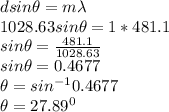
Physics, 05.05.2020 05:45, cupcake3103670
Understanding a particular spectrum is important in many areas of science, including physics and chemistry, where it can be used to identify a gas, for instance. To create a spectrum, light is generally sent through a diffraction grating, splitting the light into the various wavelengths that make it up.
1. The first step in the process is to calibrate the grating, so we know the grating spacing (the distance between the openings in the grating). Sodium has two yellow lines that are very close together in wavelength at 590 nm. When light from a sodium source is passed through a particular diffraction grating, the two yellow lines overlap, looking like one line at an angle of 35.0 degrees in the first-order spectrum. What is the grating spacing?
2. The hydrogen atom is the simplest atom there is, consisting of one electron and one proton, and it has thus been well studied. When hydrogen gas is excited by means of a high voltage, three of the prominent lines in the spectrum are found at wavelengths of656.3 nm, 486.1 nm, and 434.1 nm. When the light is passed through the diffraction grating we calibrated with sodium, at what angles will these two lines appear in the first-order spectrum? Scientists observing these lines can be confident that the source of the light contains hydrogen.
a. 646.3nm line (degree)
b. 481.1nm line (degree)

Answers: 3
Other questions on the subject: Physics



Physics, 22.06.2019 22:50, kinziemadison12
Which lists correctly orders nuclear reactions from most radioactive waste generated to least waste generated within a given period of time? o a. radioactive decay, nuclear fission, nuclear fusion o b. radioactive decay, nuclear fusion, nuclear fission o c. nuclear fusion, nuclear fission, radioactive decay o d. nuclear fission, nuclear fusion, radioactive decay
Answers: 3

Physics, 23.06.2019 09:30, jonathanjenkins701
The vector a? is 3.50 cm long and is directed into this page. vector b? points from the lower-right corner of this page to the upper-left corner of this page and has the components bx=-19.5 cm , by=25 cm. in the right-handed coordinate system, where the +x-axis directed to the right, the +y-axis toward the top of the page, and +z-axis out of the page, find the x-component of the vector product a? ×b? , measured in cm2.
Answers: 1
Do you know the correct answer?
Understanding a particular spectrum is important in many areas of science, including physics and che...
Questions in other subjects:

Mathematics, 27.07.2019 23:00


History, 27.07.2019 23:00




Biology, 27.07.2019 23:00




















